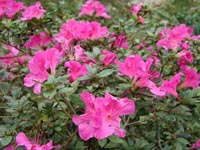Resource Library
Plant of the Week: Encore Azalea
The University of Arkansas System Division of Agriculture does not promote, support or recommend plants featured in "Plant of the Week." Please consult your local Extension office for plants suitable for your region.
Plant of the Week
Encore Azalea
Latin: Autumn Amethyst

Hurricanes Katrina and Rita have pummeled the Louisiana coast causing massive destruction and suffering. But amidst all the destruction, there are some bits of good news.
One bit of encouragement is that Robert E. "Buddy" Lee, the azalea breeder who lives in Independence, Louisiana, and developer of Encore azaleas, suffered minimal damage at his home and nursery.
The 23 Encore azaleas released since 1998 have taken the nursery world by storm because they extend the traditional blooming season into the fall. These new hybrids provide the traditional spring display during March and April, but they also bloom again in the fall, usually during September or early October in Arkansas.
Dr. Jim Robbins, horticulturist for the University of Arkansas Cooperative Extension Service, coordinated trials of three of the Encore selections and found differences in size, blooming date and plant performance around the state. Of the three selections in the trial, Autumn Amethyst outperformed the others. It’s slightly wider than tall, with the final height usually reaching around 4 to 5 feet. Autumn Amethyst produces single, dark pinkish-purple blooms about 2 inches across.
While new to the nursery trade, the Encore azaleas have been under development since the early 1980s when Buddy Lee initiated an azalea breeding program to incorporate fall blooming characteristics into a winter hardy, evergreen azalea. Because different parents were used for the various cultivars now available, there is still a bit of uncertainty about their actual winter hardiness, but most seem to do fine in Zone 7 and south.
The fall flowering trait primarily comes from Rhododendron oldhamii ‘Forth of July’ -- a cultivar selected from seed collected in 1968 at 2,500 feet up Taiwan’s Mount Tai Tun. The female parent used to create Autumn Amethyst was a winter hardy hybrid called ‘Karens,’a cross between ‘Hinodegiri’, the old Kurume variety, and R. yedoensis var. poukhanense, the Korean azalea. Lee selected the seedling that was to be named Autumn Amethyst in 1986 but did not receive the plant patent until 1998.
Encore azaleas are available in an array of colors, growth forms and bloom characteristics. One of the newest cultivars is Autumn Angel, the first white flowered fall blooming azalea. Two more are slated for next year, and still others will be released in the future.
Encore azaleas reliably bloom in the spring and fall, but they’re never covered with a complete carpet of flowers as you might see on an old Kurume like Hinodegiri or Coral Bells. But, these old standbys only have flowers for two weeks in the spring. These new twice-blooming azaleas, from the plants I have observed, give a good -- but not astounding -- display in the spring and fall during most years, effectively doubling the length of their bloom display of traditional cultivars.
In Fayetteville, following a late spring freeze in 2001, few springtime blooms were produced but Autumn Amethyst did bloom in the fall.
Encore azaleas have the same cultural requirements as traditional azaleas. They should have a pH between 5.0 and 5.5, a well drained organic soil and water during the summer months. Bloom is heavier in brighter locations, with areas having morning sun and afternoon shade probably the best. If pruning is required to control size, shear them in the spring just after bloom.
By: Gerald Klingaman, retired
Extension Horticulturist - Ornamentals
Extension News - October 14, 2005
The University of Arkansas System Division of Agriculture does not maintain lists of retail outlets where these plants can be purchased. Please check your local nursery or other retail outlets to ask about the availability of these plants for your growing area.